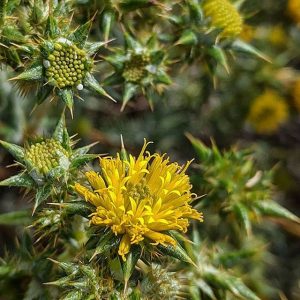African Thistle (Berkheya rigida), a fantastically prickled perennial aster introduced to Australian ports (and apparently no other global destination) in the ballast of empty ships arriving from South Africa.
In Victoria, the plant was collected in 1899 at Coode Island, once Melbourne’s great weedy arrivals terminal, and at Geelong in 1905. Those appear to have remained the only sites in Victoria where African Thistle was collected until the second half of the 20th century.
In Western Australia, African Thistle arrived around timber jetties at Bunbury and further south around Cape Leeuwin in the early twentieth century, becoming known there as Hamelin Thistle or Augusta Thistle on that basis. Although P.M. Kloot suggested that this thistle was introduced to South Australia by railway from WA, the location of the digitised SA collections near port facilities at Port Lincoln and at Ceduna is more suggestive that the plant arrived the same way it had at Augusta: in ships ballast either dumped on shore or reused as road-making materials inland.
Back in Victoria, the species was either reintroduced or newly spread from its few coastal beachheads by changing patterns of land use. In 1961, it was collected along Footscray Road, north of the Port of Melbourne; in 1976 at Point Henry near the Alcoa Pier; and in 1983 in roadside gravel on Mornington. Since then, African Thistle has become established in clusters across the inland west, as well as at various points around the bay coastal. As the seeds of African Thistle lack a feathery pappus for wind dispersal, this expanded range appears likely to have been the product of movements of contaminated sand and rock for construction, tipping of waste materials, and contamination of construction equipment and personal 4WD vehicles.
The photographed plants infest the failed subdivision of Solomon Heights in Sunshine North, a planning failure which although degraded contains a significant remnant grassland.
View Original Post on Instagram
Search for information about Berkheya rigida in the Flora of Victoria
View information and occurrences of Berkheya rigida on the Atlas of Living Australia











